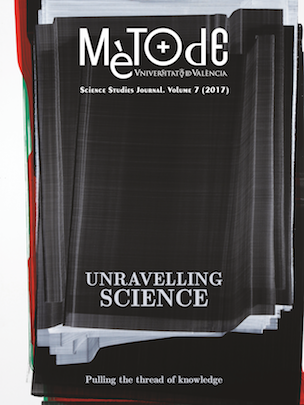A mysterious Universe: Revealing the bright and dark sides of the cosmos
DOI:
https://doi.org/10.7203/metode.7.8793Keywords:
cosmology, astrophysics, baryons, dark matter, dark energy Abstract
Abstract
Why is our universe as we observe it? Will it be the same forever? Understanding the nature of the main constituents of the universe is crucial to obtain a precise description of the way in which it reached its present state. Nowadays, many independent observations support a picture in which the matter content of the universe is shared between an ordinary and observable baryonic component (~5?%) and an invisible dark matter (~23?%). The remaining ~72?% of the universe content is in the form of a completely mysterious dark energy field. This composition emphasizes that, while ~95?% of our universe represents a major uncertainty for us, even the minor contribution from normal and, apparently, known matter entails important challenges for cosmologists.
 Downloads
Downloads
 References
References
Bull, P., Akrami, Y., Adamek, J., Baker, T., Bellini, E., Beltrán Jiménez, J., ... Winther, H. A. (2016). Beyond LCDM: Problems, solutions, and the road ahead. Physics of the Dark Universe, 12, 56–99. doi: 10.1016/j.dark.2016.02.001
Eckert, D., Jauzac, M., Shan, H., Kneib, J. P., Erben, T., Israel, H., ... Tchernin, C. (2015). Warm-hot baryons comprise 5-10 per cent of filaments in the cosmic web. Nature, 528, 105–107. doi: 10.1038/nature16058
Hamilton, J. Ch. (2013). What have we learned from observational cosmology? Studies in History and Philosophy of Science Part B: Studies in History and Philosophy of Modern Physics, 46(A), 70–85. doi: 10.1016/j.shpsb.2013.02.002
Hernández-Monteagudo, C., Ma, Y.-Z., Kitaura, F. S., Wang, W., Génova-Santos, R., Macías-Pérez, J., & Herranz, D. (2015). Evidence of the missing baryons from the kinematic Sunyaev-Zeldovich effect in Planck data. Physical Review Letters, 115(19). doi: 10.1103/PhysRevLett.115.191301
Moskowitz, C. (2016, April 11). Cosmic speed measurement suggests dark energy mystery. Scientific American. Retrieved from http://www.scientificamerican.com/article/cosmic-speed-measurement-suggests-dark-energy-mystery/
Olmo, G. J. (2012). Open questions in cosmology. Rijeka: InTech. doi: 10.5772/45746
Riess, A. G., Macri, L. M., Hoffmann, S. L., Scolnic, D., Casertano, S., Filippenko, A. V., ... Foley, R. J. (2016). A 2.4 % determination of the local value of the Hubble constant. The Astrophysical Journal, 826(1). doi: 10.3847/0004-637X/826/1/56
Downloads
Published
How to Cite
-
Abstract1114
-
PDF501
Issue
Section
License
![]()
All the documents in the OJS platform are open access and property of their respective authors.
Authors publishing in the journal agree to the following terms:
- Authors keep the rights and guarantee Metode Science Studies Journal the right to be the first publication of the document, licensed under a Creative Commons Attribution-NonCommercial-NoDerivatives 4.0 International License that allows others to share the work with an acknowledgement of authorship and publication in the journal.
- Authors are allowed and encouraged to spread their work through electronic means using personal or institutional websites (institutional open archives, personal websites or professional and academic networks profiles) once the text has been published.





